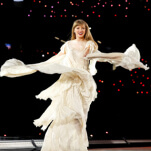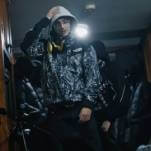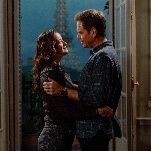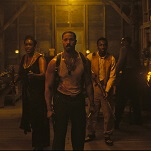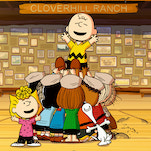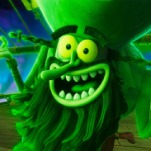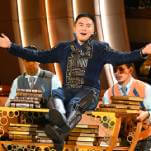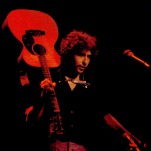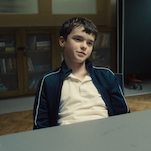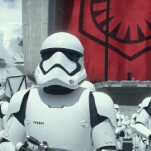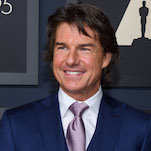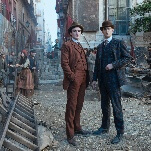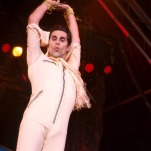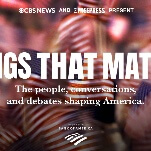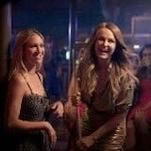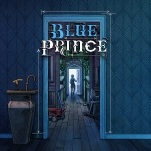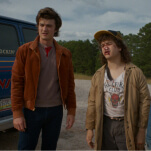The appeal of The Avengers’ stylish, lascivious vision of Britishness

“The strange thing about the English character is that they understate everything. It’s considered bad form to comment on the food, money, romance, any of those things. So you underplay it.” —Patrick Macnee, The Avengers: The Inside Story
The British Invasion didn’t begin and end with The Beatles, or even with the hordes of fabulously attired young rockers who trailed behind. At a time when the United States was seeing ideological disagreements and generation gaps become increasingly bitter and violent—provoking a “grass is greener” complex on a national scale—the mania for all things U.K. spread quickly from pop music to cinema, art, and fashion. In the mid-’60s, America became practically besotted with the English, evidently impressed by how the public faces of Great Britain seemed comfortable with contradictions—holding dry wit and art-school absurdity in equal esteem, and allowing reserved clothing and mod gear to coexist with minimal mutual affront.
By the time The Avengers debuted in the States in 1966, the show had been airing in the U.K. for five years, and was already a phenomenon overseas. In 1960, Sydney Newman created the flop dramatic series Police Surgeon, starring Ian Hendry as a doctor who keeps getting drawn into criminal intrigue. In 1961, Newman and Hendry modified the concept, casting Hendry as a more ordinary doc named David Keel, who joins forces with secret agent John Steed when Keel’s fiancée is killed by gangsters. Shot live-to-tape, The Avengers relied heavily on the interplay between the dashing, earnest Hendry and his co-star Patrick Macnee, who played Steed as “the lascivious dandy… the whimsical but efficient killer on behalf of his country.” (That’s according to Newman, in Macnee’s memoir, The Avengers: The Inside Story.) Hendry left The Avengers after the first series, replaced by a rotating cast of partners for Steed in the second series, until Honor Blackman’s leather-suited, judo-kicking Cathy Gale captured the public’s imagination, and became Macnee’s official co-star. In its third series—which aired in 1963 and ’64, at the dawn of the “Swinging London” era—The Avengers came into its own, with more tongue-in-cheek humor, more outlandish world-domination plots, and more contrast between the vigorously youthful Mrs. Gale and the bowler-hatted, umbrella-sporting Steed.
Just before The Avengers switched from tape to film—hand-in-hand with its pickup by the ABC network in the U.S.—Blackman quit the show to play Pussy Galore opposite Sean Connery’s James Bond in Goldfinger. Enter Diana Rigg as Emma Peel (a play on “m. appeal,” with the “m” meaning “man”). Rigg had a lot to live up to, given Blackman’s popularity, but Mrs. Peel quickly became another fan favorite, and the episode “Death At Bargain Prices” is a major reason why.
Originally broadcast in the U.K. on October 21, 1965 (and in the U.S. on April 11, 1966), “Death At Bargain Prices” arrived early in The Avengers’ fourth series, after the show had taken a full year off, first in preparation for a movie that never happened, and then to find a replacement for Blackman, and to adjust to shooting on film. Director Charles Crichton—best-known for helming a handful of classic Ealing Studios comedies, and later in life co-writing and directing the John Cleese classic A Fish Called Wanda—is quoted in Macnee’s memoir as saying that he fell in love with shooting The Avengers on film, and put Macnee and Rigg through their paces, forcing them to hit exact marks so he could play around with zoom lenses and cockeyed angles. Crichton’s exactitude paid off. If nothing else, “Death At Bargain Prices” is strikingly stylish for an hourlong television episode, beginning with its atmospheric opening shots of an empty department store festooned with giant inflatable Bugs Bunnys and Yogi Bears.
The scene-setting comes to an end when an agent named Moran gets killed in Pinter’s department store, after stumbling onto a meeting he wasn’t supposed to see. So Steed invites Peel to meet him at Pinter’s, and gives her an assignment to go undercover as an employee and find out what’s going on with the new owners, who seem to be running the store into the ground. Meanwhile, Steed, posing as an efficiency expert, follows the leads Peel feeds him, finding out what’s in the head of Pinter’s new honcho: the wheelchair-bound Horatio “King” Kane, currently consigned to “the department of discontinued lines.” It turns out that Kane and his henchmen have abducted a nuclear physicist and have instructed him to convert the entire building into a nuclear bomb, designed to go off when any customer takes an elevator to the basement to buy a washing machine.
Kane is the very model of the “talking killer,” who reveals more than he should because, in his own words, “I’m proud of my scheme! I want them to know!” But Kane’s conversations with Steed are also quintessential Avengers, because they’re about the vanishing way of life Kane is trying to preserve through violent threat. “A man can possess a Michelangelo and still appreciate a Picasso,” Kane says, by way of acknowledging that not everything modern is awful. But he also says this while praising the solidly well-built products of British industry’s past, and decrying the cheap plastic crap of this new age. The King would rather be surrounded by old-fashioned motorcars than inflatable Yogi Bears.
Visually, Steed and Peel represent the two sides of that same divide, but they don’t behave as such. Steed raises the occasional eyebrow at Peel’s fashionable duds, or at the giant eyeball she uses for a peephole on her front door, but he trusts her implicitly. And as with the Macnee/Blackman chemistry, the interplay between Macnee and Rigg was central to The Avengers’ success. Steed and Peel were flinty and flirty, often teasing each other about their quirks. Writer Brian Clemens—the major creative voice on The Avengers—integrates that friction into the script for “Death At Bargain Prices,” parceling out plot details while the two stars spar. Often, what’s most memorable about “Death At Bargain Prices” isn’t the way the heroes piece together Kane’s plot, but rather the way Steed browses for bowlers—telling a clerk, “I’d like 12 of these, on account!”—and the way Steed and Peel share information while playing with marionettes that look like little versions of themselves. (Beneath their tiny hat and wig, the puppets are actually Colonel Steve Zodiac and Doctor Venus from Gerry Anderson’s Fireball XL5 marionette adventure show.)
“Death At Bargain Prices” takes place almost entirely at Pinter’s, on a set wholly constructed on a soundstage, relying on editing and camera movement to make it look like a huge, multi-story store. Clemens gives Crichton plenty to work with by transferring Peel to different departments from act to act, necessitating a change in scenery and costume. While working in the toy department, Mrs. Peel dons her own version of the superheroine-like leather catsuit that Cathy Gale so often wore, thus giving Rigg her iconic look. And while Peel is working in the lingerie department, Steed delivers one of the most famous lines in Avengers history to her: “I asked the chief predator where to find you and he said, ‘Our Mrs. Peel is in ladies’ underwear.’ I rattled up the stairs three at a time.” In that same scene, Steed sneaks a peak at Peel’s cleavage, before she peevishly covers up her plunging neckline.

